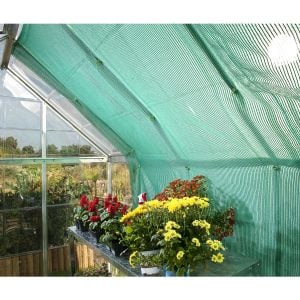
One recent sunny day I forgot to open my greenhouse doors and windows in the morning, and by noontime the temperature inside had reached 108˚. The plants were sadly wilted, so I quickly misted the entire greenhouse to lower the temperature and raise the humidity. Fortunately, by late afternoon, the sagging plants had recovered, but this plant-stressing scenario shouldn’t be repeated often. That’s why I’ve decided to invest in shade cloth.
Shade cloth provides relief from bright sun while still allowing light and rain to pass through it. Either woven or knitted, it comes in many densities from 20% to 90% shade. Because of the cloth’s open structure, wind can pass through it as well, so shade cloth won’t constantly flap on the greenhouse glass, potentially damaging the structure and causing the cloth to rip. Moreover, if the cloth is knitted, its lockstitch construction prevents it from unraveling if a tear does occur. This is a major benefit of knitted shade cloth. Woven shade cloth, on the other hand, is about 30% heavier in weight and therefore tends to have a longer lifespan overall.
Installing shade cloth on a greenhouse is not difficult. If you are putting it on the outside of the greenhouse, made-to-measure shade cloths have taped edges with grommets for tying the cloth down with rope. To help reduce the load on the greenhouse in heavy winds and rain, it’s best to take the rope to tent pegs in the ground rather than tying them to the greenhouse itself. Also, when purchasing a made-to-measure shade cloth, it’s smart to oversize your measurements slightly to ensure complete coverage.

On the inside of the greenhouse, it is best to order a shade system with pulleys and roping, like Hartley Botanic offers with their greenhouses.
Shade cloth comes in different colors to suit your particular needs. For example, you might install white shade cloth in a very sunny summer climate because white’s reflection of the sun’s rays will reduce heat buildup beneath the cloth while still shading your plants. Other colors of shade cloth can be used not just for decorative purposes, but also to manipulate which portions of the light spectrum reach the plants below, in this way affecting their patterns of growth and development.
Shade cloth ranges in price depending upon the type and density of the fabric and the amount of custom treatment. The cheapest option is to purchase the cloth is a bulk roll that you cut and finish yourself. The most expensive, but less labor-intensive approach is to purchase a made-to-measure shade cloth that is fully taped and grommeted to your specifications. Or purchase roller shades.


